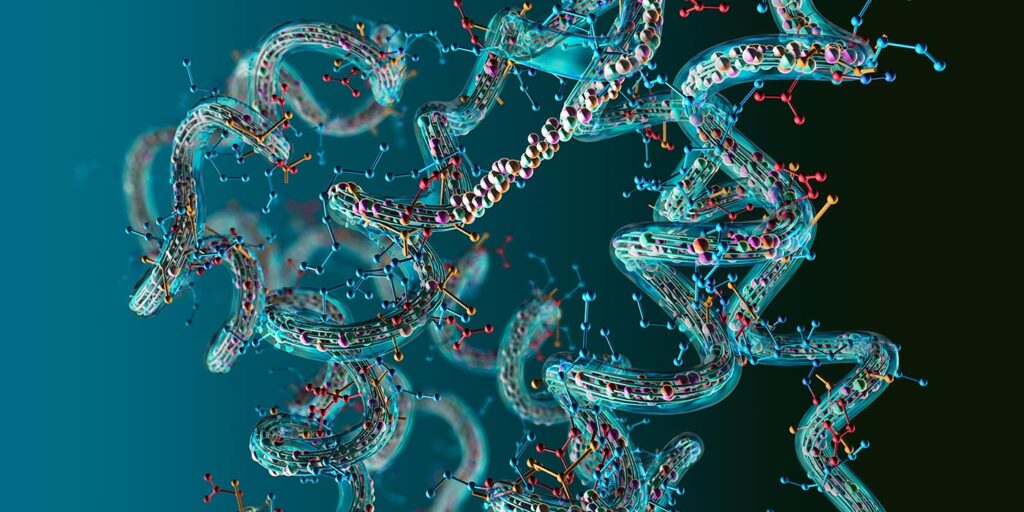A novel strategy developed by scientists at Rice University allows scientists to zoom in on tiny segments of proteins inside living cells, revealing localized environmental changes that could indicate the earliest stages of diseases such as Alzheimer’s, Parkinson’s, and cancer. The study results could offer promise for drug screening that targets protein aggregation diseases.
The research team engineered a fluorescent probe known as AnapTh into precise subdomains of proteins, creating a tool that monitors microenvironmental shifts in real time. Unlike conventional techniques that provide only broad signals, this approach reveals how distinct regions of the same protein behave differently during the aggregation process. The work, led by Han Xiao, PhD, professor of chemistry and director of Rice’s SynthX Center, enhances the basic understanding of disease mechanisms and lays the groundwork for identifying drug targets and screening potential therapeutics at an earlier stage.
“We essentially built a molecular magnifying glass,” Xiao said. “This allows us to visualize subtle environmental changes that previously went unnoticed, and those early changes often hold the key to understanding protein-related diseases.” Xiao and colleagues reported on their findings in Nature Chemical Biology, in a paper titled, “Real-time imaging of protein microenvironment changes in cells with rotor-based fluorescent amino acids,” in which they concluded: “These results demonstrate that the technology reported in this paper provides a versatile tool for exploring microenvironment changes of protein substructures at high spatial resolution, enabling direct visualization of the local environment around specific amino acid residues.”
Most proteins are composed of multiple domains, each having distinct environmental sensitivity and specialized functions, the authors explained. “Changes in the microenvironment of a protein or its subdomains can trigger partner binding, protein aggregation, clustering, or other processes that are closely linked to cellular regulatory pathways and a range of human diseases.” In functional proteins, the assembly and disassembly of these domains are tightly regulated, while protein aggregation is dysfunctional, involving less reversible intermolecular interactions between protein domains, the team continued.
“Monitoring microenvironmental changes within these protein substructures can therefore provide important insights into various human diseases and potentially guide the development of new therapeutic strategies … Therefore, there is a critical need for a method capable of detecting microenvironmental changes within specific protein domains at high resolution.”
To explore how individual protein segments behave during aggregation, the researchers hypothesized that local environmental changes precede visible clumping. Based on that hypothesis, they designed AnapTh, a small fluorescent amino acid whose emission spectrum shifts based on its microenvironment. Using genetic code expansion, the team inserted this probe at specific sites without altering protein folding or function. “This genetically incorporated AnapTh can replace the large fluorescent proteins or protein tags that have been previously used in protein labeling, minimizing the impact of the labeling probes on the functions of target proteins,” the investigators explained.
By tracking changes in fluorescence within living cells, the research team monitored the real-time responses of targeted subdomains. This technique provided a level of spatial resolution and temporal monitoring unmatched by existing tools. “To demonstrate the utility of our approach, we have investigated microenvironmental changes at individual residues using four illustrative protein systems—hSOD1, Htt, STIM1, and CRY2—that either reversibly form aggregates or assemble into clusters of varying shapes and sizes in response to distinct stimuli,” the authors stated.
“We wanted a method to light up just one spot in a protein and watch what happens around it in live cells,” said graduate student and co-first author Mengxi Zhang. “When aggregation starts, some parts become denser and more hydrophobic, while others remain unchanged. Our tool detects those distinctions nearly instantly.” When applying their technique to disease-related proteins, the researchers discovered that aggregation is far from uniform. Specific subdomains exhibited increased fluorescence intensity and spectral shifts, indicating heightened crowding and altered chemical surroundings, while other regions remained stable. These findings suggest that aggregation initiates at discrete “hot spots” before spreading.
This uneven process challenges traditional models that view protein aggregation as a homogeneous phenomenon. Instead, it highlights a more nuanced progression, where early localized misfolding events could serve as biomarkers or therapeutic entry points—results that provide a new perspective for studying protein aggregation at the molecular level.
The ability to detect early subdomain-specific changes opens opportunities to monitor neurodegenerative and protein misfolding disease progression more sensitively and to identify small molecules that intervene before aggregation spreads.
The implications span from molecular biology to pharmaceutical innovation. The team suggested that their system “… will enable a broad range of proteostasis studies, provide high-resolution insights into the relationship between protein microenvironmental changes and function, and should advance our understanding of how large-scale biomolecular assemblies form any function in cells.”
Co-first author and graduate student Shudan Yang added, “This platform gives us a jump start. Now we can test potential inhibitors and see at the very first sign of trouble whether they prevent local misfolding. That kind of precision screening is what drug discovery needs.” In their paper, the team concluded, “In this study, we have developed a strategy to visualize the microenvironmental variations of protein subdomains with exceptional spatial resolution in live cells … These results confirm the sensitivity of the rotor-based AnapTh probe for detecting microenvironmental changes surrounding individual residues, highlighting its broad applicability in both biochemical and biomedical research.”

